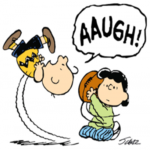
 A bunch of female sheep walk into a bar in New Jersey.
A bunch of female sheep walk into a bar in New Jersey.
The bartender says, “Hey, what’re ewes doin’ in here?!”

 A bunch of female sheep walk into a bar in New Jersey.
A bunch of female sheep walk into a bar in New Jersey.
The bartender says, “Hey, what’re ewes doin’ in here?!”

 If you were surprised at my take on the nature of literature in “Evolutionary psychology and the do’s and dont’s of writing archetypes,” the far-more-popular literature website The Millions recently published a good survey of evolutionary literary theory: “On the Origin of Novels? Encountering Literary Darwinism.”
If you were surprised at my take on the nature of literature in “Evolutionary psychology and the do’s and dont’s of writing archetypes,” the far-more-popular literature website The Millions recently published a good survey of evolutionary literary theory: “On the Origin of Novels? Encountering Literary Darwinism.”
First let me get this out of the way…

 Speaking of recurring patterns in fiction!
Speaking of recurring patterns in fiction!
Tonight’s episode (I’m writing this near midnight on Saturday the 8th) of the Starz series Black Sails features an 18th century literary character destroying a document to keep its information from falling into the wrong hands, only to recreate it later from memory. This is intriguing because the last episode of the Fox series Sleepy Hollow also features an 18th century literary character destroying a document to keep its information from falling into the wrong hands, only to recreate it later from memory.
In Sleepy Hollow, the character was Ichabod Crane from Washington Irving’s “The Legend of Sleepy Hollow,” who (in the series) is a soldier from the American Revolution transported to modern-day New York state. The document he recreated from memory was a map to purgatory, which he destroyed so the demon Moloch couldn’t use it.
In Black Sails, the character was John Silver from Robert Louis Stevenson’s Treasure Island, who (in the series) is a young cook on board Captain Flint’s vessel Walrus. The document he recreated from memory was the schedule of the treasure ship Urca de Lima, which he destroyed so Captain Flint wouldn’t be able to kill him for stealing it.
Notably, while Crane’s television story is shifted considerably forward in time from the source material, Silver’s is shifted backward.
Quite curious.


“We cannot resist this new Power. We must join It!”
A new Tumblr feed by Valerio Amaro presents this intriguing what-if:
“What would happen if J. R. R. Tolkien worked in advertising?”
The results are often funny, always cool. As Tolkien himself said, “all we have to decide is what to do with the time that is given us,” so take some of your time to check out One Ad To Rule Them All!

 I’m out on a Saturday night, after having a long conversation with author John Austin, whose non-fiction short, “Planet Zero,” is now available in the critically acclaimed anthology Salaam Love: American Muslim Men on Love, Sex, and Intimacy.
I’m out on a Saturday night, after having a long conversation with author John Austin, whose non-fiction short, “Planet Zero,” is now available in the critically acclaimed anthology Salaam Love: American Muslim Men on Love, Sex, and Intimacy.
The rest of the evening will be spent typing up some posts, which I will schedule for publication throughout the coming week.
Some thoughts that are buzzing through my head: Continue reading

 The other day, while discussing the evolutionary psychology of archetypes, I touched on the controversy about using patterns in writing: specifically the story-pacing “beat sheet” popularized by Blake Snyder in his Save the Cat! series, which has come under attack as a scourge of quality writing.
The other day, while discussing the evolutionary psychology of archetypes, I touched on the controversy about using patterns in writing: specifically the story-pacing “beat sheet” popularized by Blake Snyder in his Save the Cat! series, which has come under attack as a scourge of quality writing.
Peter Suderman at Slate blamed the recent trend of spectacular awfulness in film-making on Snyder’s beat sheet, but former MGM Studio Executive Stephanie Palmer vehemently disagreed, pegging as the real culprit the fact that movies are “incredibly hard to make.” Palmer’s primary methodology is to set up straw-man syllogisms to (mis)represent Suderman’s point-of-view, then fail to address the formal errors in the syllogisms she invents while making inane assertions that in no way rule out anything Suderman said.
Not. Thinking. It. Through.
But the main reason I want to respond is that she resorts to the laughable George W. Bush excuse for failure: “It’s hard work!” If you find a job too hard, let someone else do it!